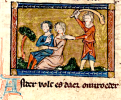Hi_Henry
The Living Force
While roaming through twitter accounts I happened on a thread where an interesting image appear.
This image prompted me to think, "What is the man with the club going to do ?"

The image is from an illustrated book published much later of the poem "Der Naturen Bloeme" (1270) by the pioneer of the didactic poetry Jacob van Maerlant, (born 1225, Vrije van Brugge [Damme?].
I for one have no clue, but on first glance it sure doesn't look to be a pleasant one.
Some fascinating analysis is found here.
 canon2015.literairecanon.be
canon2015.literairecanon.be
This image prompted me to think, "What is the man with the club going to do ?"

The image is from an illustrated book published much later of the poem "Der Naturen Bloeme" (1270) by the pioneer of the didactic poetry Jacob van Maerlant, (born 1225, Vrije van Brugge [Damme?].
So what is the lesson is being taught in that image ?Didactic poetry, which was not regarded as a separate genre by either Greek or Roman theorists, embraces a number of poetic works (usually in hexameters) which aim to instruct the reader in a particular subject-matter, be it science, philosophy, hunting, farming, love, or some other art or craft.
I for one have no clue, but on first glance it sure doesn't look to be a pleasant one.

Some fascinating analysis is found here.
Maerlant actually has every reason to place himself in the foreground. Not only did he already have an impressive body of work behind him when he wrote The Flower of Nature, but this book was a remarkable effort, a comprehensive overview of all that was known about creation during his age. Nature processes past the reader’s eyes in alphabetical order over the course of thirteen books of very different lengths (a total of about 17,000 verses): diverse human beings, four-legged animals, birds, water monsters (like the crocodile and the mermaid), fish, snakes, insects, “ordinary” trees, spice trees, herbs, springs, stones and metals. No other writer had ever done this before in the vernacular, not in the Netherlands and not even in Europe. So that is why Maerlant – in another unusual move for the thirteenth century - proudly recorded the title of his work: der naturen bloeme, which simply means “the best of nature”.
Der naturen bloeme (The Best of Nature) | Frontend Boilerplate
In our era of self-profiling, it may seem normal for an author to make themselves known in the first line of their work, but it was quite the opposite in the…
